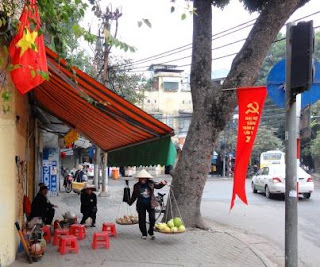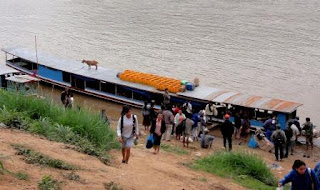We are still entranced by travelling a country by boat, so enjoying sitting back and watching the world and its changing vistas sweep past. The river and countryside on the Cambodian side of the Vietnam border was quieter than in its neighbouring country where our boat trips had revealed busy floating markets and fishing as well as incredible industry on the river including commercial scale dredging of sand from the river bed – a highly prized (and priced) commodity used for construction in this low lying, silty / muddy delta area. In Cambodia we saw far less river traffic, fewer farmers, almost no industry immediately apparent; however, the agriculture appeared to be more extensive large-farm business, very different from the market-garden type businesses we had seen lower down the river.
This changes as you approach Phnom Penh and turn from the Mekong onto one of its tributaries, the Tonle Sap River: most of the river traffic in this part is carrying dredged building sand.... and why more of these sand carriers do not sink is a mystery! In the photo, the one at the back (laden) used to have a waterline as the one in the foreground…. And yes, it is moving! They are fully laden to the extent that the decks are awash and they constantly pump out the water that is flooding in. We saw one that was so overloaded that a second boat had tied on alongside to help with pumping out water simply to keep it afloat!! Clearly there are incentives to arrive with plenty of cargo....
Phnom Penh
Our first sighting of Phnom Penh was the ornate pagoda roofing of the Royal Palace from the river: exotic and beautiful! PP is a relatively young city and very modern in appearance, with an extensive waterfront (Sisowath Quay) adorned with flags from almost every country, and lawns providing space for jogging and martial arts exercises in front of the restaurants, bars and hotels. A great place for watching the sunset over the Royal Palace and Silver Pagoda (Erik’s pic below).
Two days in this young city (1800’s) was spent walking the streets (apart from the main streets, little attention is paid to street names; they are all simply given numbers: even numbers run one way and odd numbers the other), and visiting markets and Buddhist Pagodas (Cambodian Wats / temples).
Cambodia is recovering from decades of warfare and violence, including carpet-bombing by the Americans during the Vietnam / American war and then four years of rule by Pol Pot and his genocidal Khmer Rouge in their brutal ‘restructuring’ of Cambodian society to make it more Maoist and peasant-oriented. Everyone knows the history, but a visit to the Choeung Ek Memorial (at one of the “Killing Fields” which are described as “… ad hoc places for execution and dumping grounds for dead bodies during the Khmer Rouge regime 1975-1979”); and Tuol Sleng Genocide Museum (former S-21 prison) is sobering but, we felt, necessary to try to get a better understanding of what the people had endured.
We left PP on a north-bound bus for Siem Reap - a 350km journey; air-conditioned and sufficiently comfortable.... and costing only $6!!!! Generally the buses in SE Asia are very good…. not luxury but they work well, are clean, perfectly adequate seats (no, not reclining), comfortable for 6+ hours and very cheap. They always leave on time - but almost never arrive at the promised time!
The 6hour trip was fascinating: all homes are on stilts, with the space under the houses evidently shared by the animals (pigs, water buffalo, ducks, dogs….), children and adults as they eat, play, work or rest on their hammocks (blurry, taken-from-bus photo!). In this dry season the stilts appear unnecessary but Cambodia has, for half the year, the biggest fresh-water lake in SE Asia…. The Tonle Sap Lake. When the rains come the Mekong River pushes up into its Tonle Sap river tributary which then reverses direction and causes the lake to expand 10-fold. In a flat country the effect on the landscape and on the lives of the inhabitants is incredible.
Siem Reap and the Angkor Archaeological Park
Siem Reap, Angkor Wat, Banteay Srei…. For so much of my life I have savoured these exotic words in my head and tried to visualise what they represented. Well, it was all far bigger and more wondrous than my imagination could dare.
The millennium-old ruins of the Angkorian-era Khmer Empire, the Angkor Archaeological Park, is a UNESCO World Heritage Site and described as the largest religious monument ever constructed. Angkor literally means “Capital City” or “Holy City” and now refers to the capital city (cities, actually) of the Khmer Empire (900 to 1300 AD) and also to the Empire itself. The Angkor dominance once extended over all of Thailand, Laos, Vietnam and Kampuchea (Cambodia).
Obtaining a three-day pass, we went there by tuk-tuk: a wonderful way to see the transition from the busy Siem Reap town to rural sights amongst quiet villages and farming areas.
Entering the Angkor Park, we enjoyed avenues of trees surrounding large lakes, were surprised to see a few villages within the park itself, then exclaimed around each corner as we came upon many large and small ruins, all revealing something of ancient Khmer architecture, civilisation and art. We were taken aback by the huge expanse of land that is the Angkor Park (97 sq km), and the fact that this houses dozens of temples, mostly the remnants of a succession of Angkorian empires. At its peak, this area contained more than a million people and the Khmer kings built extensive waterworks and other infrastructure to service the temple structures.
A timeline of the Angkor area shows the successions of kings, dominance of religions (the shift from Hinduism to Shivaism, again Hinduism then Buddhism) and associated archaeological styles is useful; guidebooks help, as can guides; but much of the beauty of the place is in moving away from the throngs, finding a space and simply absorbing the magnitude and history of it all, trying to visualise the circumstances and people of the time and marvelling at the construction, architecture and artwork.
The sandstone and laterite crumbling stone reliefs, great towers, palaces, temples, passageways, magnificent carvings, jungle backgrounds, moats and high walls seen all around the park make this a fascinating and mysterious destination.
Angkor Wat (top photo; surrounded by a moat and high exterior wall) is legendary for its artistic and archaeological significance, with many of the walls covered with bas-reliefs and carvings depicting the story of the times, interwoven with legend;
the giant faces of Bayon (four carved faces on each of more than 30 towers, oriented towards the cardinal points) are spectacular, recognisable images;
at the Ta Prohm Temple enormous fig, banyan and silk-cotton trees have been allowed to encroach on the temple structure, giving it a creepy atmosphere (and providing the site of the movie Tomb Raider!). But there is incredible beauty and fascination in all of the sites… you need to give yourself time, wear a hat and lots of sunscreen, take litres of water, be patient outside the temple areas where a myriad vendors sell souvenirs and trinkets for a dollar, and – when you get “templed-out” – return to Siem Reap to recover for the next day’s trip!
Siem Reap is the town near the Angkor Park, and also a great place to visit for itself! The town is a cluster of villages that developed around individual pagodas, and these villages are now linked together. The colonial architecture, Old French Quarter and Old Market make it a fun place to hire a bicycle and roam the streets, stopping off for a cheap beer or coffee, or a massage (or even a fish-massage, see Rolf below...) for those aching limbs!
We found a great, cheap place to stay in the heart of the old town and at the entrance to the night market (at $15 per night our room was the most expensive in the place, but WE had private bathroom, hot shower and aircon! Hmm… this was, however, after two days of mishaps with accommodation…). The town, however, is bursting with tourists and offers an incredible range of hotels and guest houses, from very pricey to a dodgy $2 per night!
The range of bars and restaurants reflects tourist needs too, but we ate and drank wonderfully well, as usual. Generally throughout SE Asia our plates of food seldom went above $4 (Rolf once went big with a $6 main meal!) and we had some meals-with-drinks-for-4 that came to a princely $12 total. Generally "local is lekker" and we enjoy eating where and what the locals eat (above: a Cambodian BBQ at a food court… in front of their bar, clearly!), savouring the tastes and textures of local cuisine and coffee (strong... with a dash of condensed milk...) but occasionally the lure of the familiar (grilled meat, latte coffee) takes you to a westernised place where you pay the penalty (although that is never more than we would pay back in SA).
Siem Reap is a real tourist town, with its “Pub Street”, entertainers and vendors in abundance, but it is so easy to support the local vendors ($1 = 4000 riel, but dollars are used everywhere and the goods are extremely cheap), be entertained and enjoy the cheap pubs so a visit is memorable and repeat visits advised. The deep contrast of the light entertainment of the town with the exotic mystery of Angkor Park make for an irresistible destination.













































